Signs of a dairy intolerance. Understanding Lactose Intolerance: Symptoms, Causes, and Management
What are the symptoms of lactose intolerance? What causes this condition? How can it be managed? Explore the details of lactose intolerance and find answers to your questions.
Lactose Intolerance: An Overview
Lactose intolerance is a digestive condition where individuals are unable to fully digest the sugar (lactose) found in milk and dairy products. As a result, they may experience unpleasant symptoms like diarrhea, gas, and bloating after consuming dairy-based foods. Also known as lactose malabsorption, this condition is usually harmless but can be quite uncomfortable for those affected.
The Role of Lactase Enzyme
Lactose intolerance is primarily caused by a deficiency of the enzyme lactase, which is produced in the small intestine. Lactase is responsible for breaking down lactose into simpler sugars, glucose and galactose, that can be absorbed by the body. When lactase levels are too low, the undigested lactose moves into the colon, where it interacts with bacteria, leading to the symptoms of lactose intolerance.

Types of Lactose Intolerance
There are three main types of lactose intolerance, each with its own underlying cause:
- Primary Lactose Intolerance: This is the most common form, where lactase production naturally declines as individuals age, making it difficult to digest dairy products.
- Secondary Lactose Intolerance: This type occurs when the small intestine’s ability to produce lactase is reduced due to an underlying illness, injury, or surgical procedure.
- Congenital or Developmental Lactose Intolerance: This rare form is present at birth, either due to a genetic condition or premature birth, where the infant has insufficient lactase levels.
Symptoms of Lactose Intolerance
The signs and symptoms of lactose intolerance typically appear within 30 minutes to 2 hours after consuming dairy products. Common symptoms include:
- Diarrhea
- Nausea, and sometimes vomiting
- Abdominal cramps
- Bloating
- Gas
Risk Factors for Lactose Intolerance
Several factors can increase the risk of developing lactose intolerance, including:

- Increasing age: Lactose intolerance is more common in adulthood as lactase production declines.
- Ethnicity: Individuals of African, Asian, Hispanic, and American Indian descent are more prone to lactose intolerance.
- Premature birth: Infants born prematurely may have reduced lactase levels.
- Diseases affecting the small intestine: Conditions like bacterial overgrowth, celiac disease, and Crohn’s disease can contribute to lactose intolerance.
- Cancer treatments: Radiation therapy for stomach cancer or chemotherapy-related intestinal complications may increase the risk of developing lactose intolerance.
Diagnosing Lactose Intolerance
If you frequently experience symptoms after consuming dairy products, it’s important to consult your doctor. They may recommend one or more of the following tests to diagnose lactose intolerance:
- Lactose tolerance test: This measures your body’s response to a lactose-containing drink to determine if you are lactose intolerant.
- Hydrogen breath test: This test measures the amount of hydrogen in your breath after consuming a lactose-containing solution, which can indicate lactose malabsorption.
- Stool acidity test: This test measures the acidity of your stool, which can be an indicator of lactose intolerance in infants and children.
Managing Lactose Intolerance
Fortunately, most people with lactose intolerance can manage their condition without having to completely eliminate dairy from their diet. Some strategies for managing lactose intolerance include:
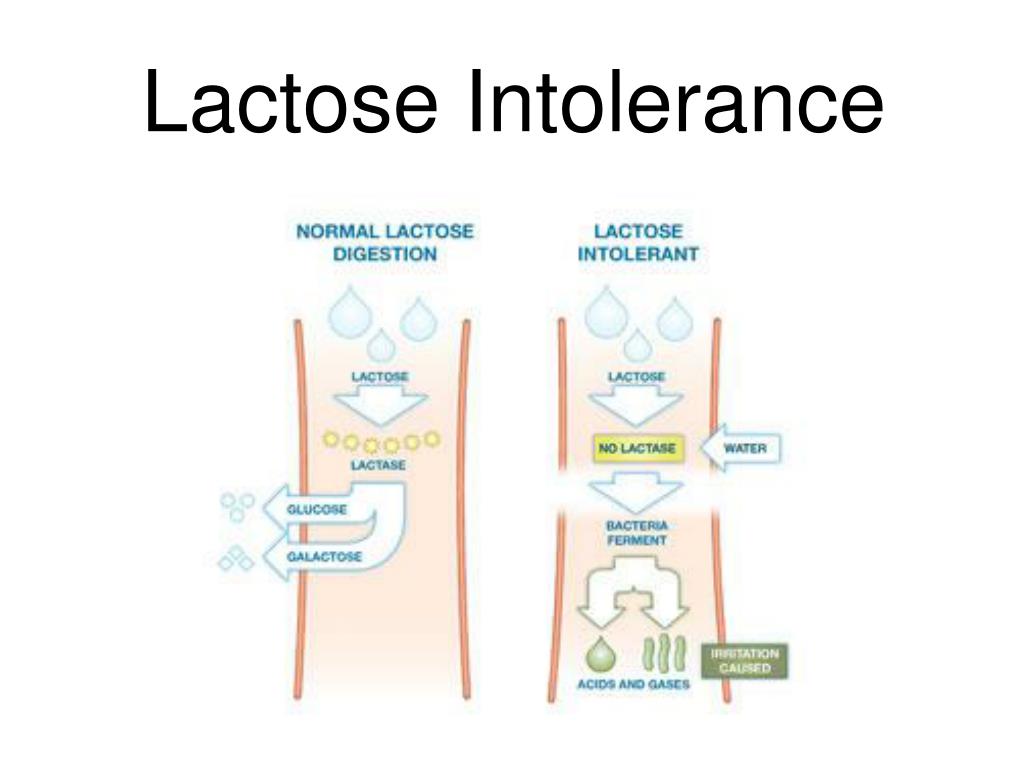
- Limiting dairy intake: Gradually reducing the amount of dairy products in your diet can help minimize symptoms.
- Choosing low-lactose or lactose-free dairy products: Options like lactose-free milk, cheese, and yogurt can be easier to digest.
- Using lactase enzyme supplements: Taking lactase enzyme tablets or drops can help break down lactose and reduce symptoms.
- Ensuring adequate calcium intake: Finding alternative sources of calcium, such as leafy greens, fortified non-dairy milk, or supplements, is important for maintaining bone health.
Seeking Medical Advice
If you are frequently experiencing symptoms of lactose intolerance, it’s a good idea to make an appointment with your doctor. They can help determine the underlying cause, provide a proper diagnosis, and recommend the best management strategies for your specific needs. With the right approach, you can effectively manage lactose intolerance and maintain a healthy, balanced diet.
Lactose intolerance – Symptoms & causes
Overview
People with lactose intolerance are unable to fully digest the sugar (lactose) in milk. As a result, they have diarrhea, gas and bloating after eating or drinking dairy products. The condition, which is also called lactose malabsorption, is usually harmless, but its symptoms can be uncomfortable.
Too little of an enzyme produced in your small intestine (lactase) is usually responsible for lactose intolerance. You can have low levels of lactase and still be able to digest milk products. But if your levels are too low you become lactose intolerant, leading to symptoms after you eat or drink dairy.
Colon and small intestine
The small intestine and colon are parts of your digestive tract, which processes the foods you eat. The intestines take nutrients from the foods. What isn’t absorbed by the intestines continues along the digestive tract and is passed as stool during a bowel movement.
Most people with lactose intolerance can manage the condition without having to give up all dairy foods.
Products & Services
Symptoms
The signs and symptoms of lactose intolerance usually begin from 30 minutes to two hours after eating or drinking foods that contain lactose. Common signs and symptoms include:
- Diarrhea
- Nausea, and sometimes, vomiting
- Stomach cramps
- Bloating
- Gas
When to see a doctor
Make an appointment with your doctor if you frequently have symptoms of lactose intolerance after eating dairy foods, particularly if you’re worried about getting enough calcium.
Causes
Lactose intolerance occurs when your small intestine doesn’t produce enough of an enzyme (lactase) to digest milk sugar (lactose).
Normally, lactase turns milk sugar into two simple sugars — glucose and galactose — which are absorbed into the bloodstream through the intestinal lining.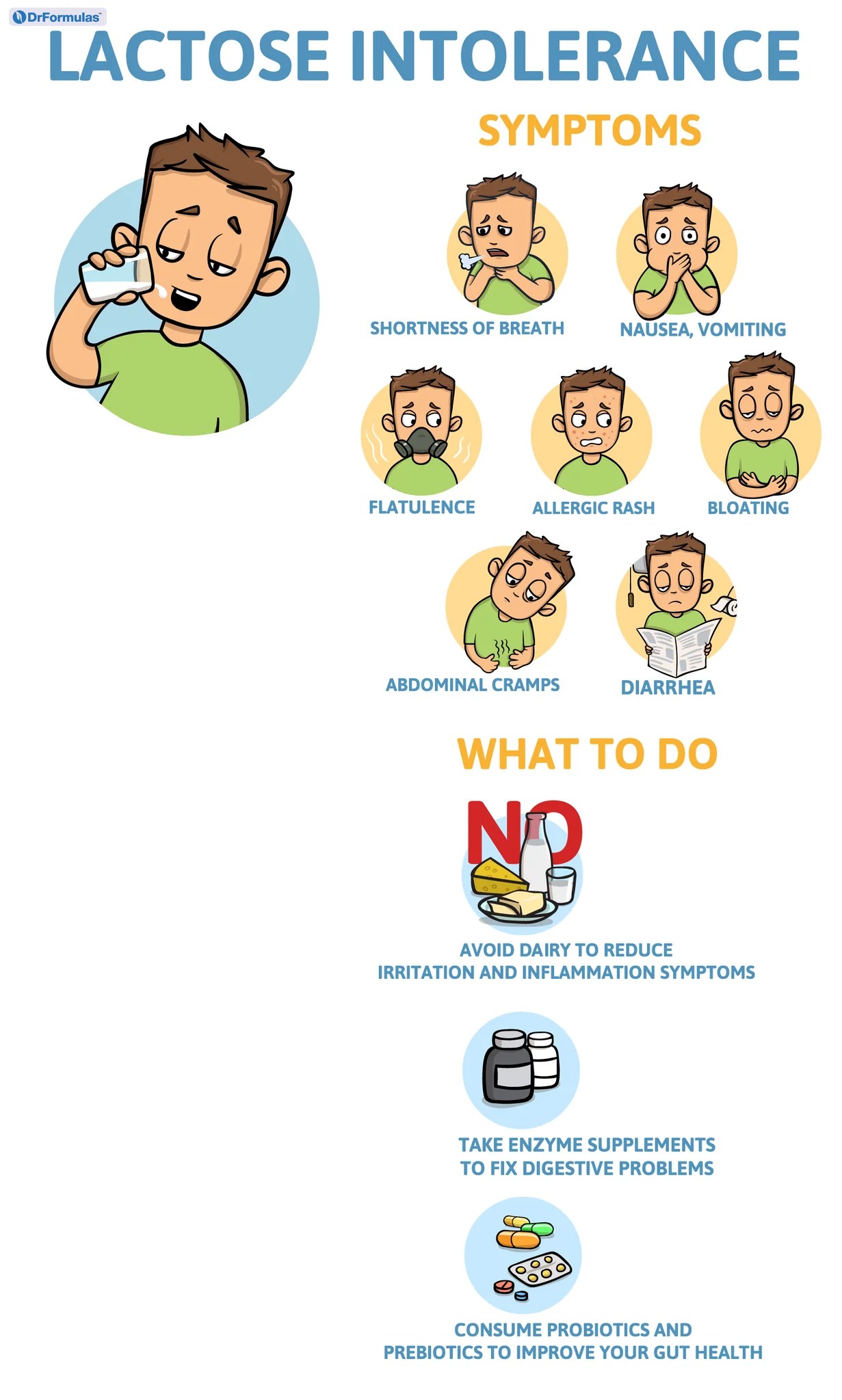
If you’re lactase deficient, lactose in your food moves into the colon instead of being processed and absorbed. In the colon, normal bacteria interact with undigested lactose, causing the signs and symptoms of lactose intolerance.
There are three types of lactose intolerance. Different factors cause the lactase deficiency underlying each type.
Primary lactose intolerance
People who develop primary lactose intolerance — the most common type — start life producing enough lactase. Infants, who get all their nutrition from milk, need lactase.
As children replace milk with other foods, the amount of lactase they produce normally drops, but usually remains high enough to digest the amount of dairy in a typical adult diet. In primary lactose intolerance, lactase production falls off sharply by adulthood, making milk products difficult to digest.
Secondary lactose intolerance
This form of lactose intolerance occurs when your small intestine decreases lactase production after an illness, injury or surgery involving your small intestine. Diseases associated with secondary lactose intolerance include intestinal infection, celiac disease, bacterial overgrowth and Crohn’s disease.
Diseases associated with secondary lactose intolerance include intestinal infection, celiac disease, bacterial overgrowth and Crohn’s disease.
Treatment of the underlying disorder might restore lactase levels and improve signs and symptoms, though it can take time.
Congenital or developmental lactose intolerance
It’s possible, but rare, for babies to be born with lactose intolerance caused by a lack of lactase. This disorder is passed from generation to generation in a pattern of inheritance called autosomal recessive, meaning that both the mother and the father must pass on the same gene variant for a child to be affected. Premature infants can also have lactose intolerance because of an insufficient lactase level.
Risk factors
Factors that can make you or your child more prone to lactose intolerance include:
- Increasing age. Lactose intolerance usually appears in adulthood. The condition is uncommon in babies and young children.

- Ethnicity. Lactose intolerance is most common in people of African, Asian, Hispanic and American Indian descent.
- Premature birth. Infants born prematurely might have reduced levels of lactase because the small intestine doesn’t develop lactase-producing cells until late in the third trimester.
- Diseases affecting the small intestine. Small intestine problems that can cause lactose intolerance include bacterial overgrowth, celiac disease and Crohn’s disease.
- Certain cancer treatments. If you’ve had radiation therapy for cancer in your stomach or you have intestinal complications from chemotherapy, your risk of developing lactose intolerance increases.
Lactose intolerance – Symptoms & causes
Overview
People with lactose intolerance are unable to fully digest the sugar (lactose) in milk. As a result, they have diarrhea, gas and bloating after eating or drinking dairy products. The condition, which is also called lactose malabsorption, is usually harmless, but its symptoms can be uncomfortable.
The condition, which is also called lactose malabsorption, is usually harmless, but its symptoms can be uncomfortable.
Too little of an enzyme produced in your small intestine (lactase) is usually responsible for lactose intolerance. You can have low levels of lactase and still be able to digest milk products. But if your levels are too low you become lactose intolerant, leading to symptoms after you eat or drink dairy.
Colon and small intestine
The small intestine and colon are parts of your digestive tract, which processes the foods you eat. The intestines take nutrients from the foods. What isn’t absorbed by the intestines continues along the digestive tract and is passed as stool during a bowel movement.
Most people with lactose intolerance can manage the condition without having to give up all dairy foods.
Products & Services
Symptoms
The signs and symptoms of lactose intolerance usually begin from 30 minutes to two hours after eating or drinking foods that contain lactose. Common signs and symptoms include:
Common signs and symptoms include:
- Diarrhea
- Nausea, and sometimes, vomiting
- Stomach cramps
- Bloating
- Gas
When to see a doctor
Make an appointment with your doctor if you frequently have symptoms of lactose intolerance after eating dairy foods, particularly if you’re worried about getting enough calcium.
Causes
Lactose intolerance occurs when your small intestine doesn’t produce enough of an enzyme (lactase) to digest milk sugar (lactose).
Normally, lactase turns milk sugar into two simple sugars — glucose and galactose — which are absorbed into the bloodstream through the intestinal lining.
If you’re lactase deficient, lactose in your food moves into the colon instead of being processed and absorbed. In the colon, normal bacteria interact with undigested lactose, causing the signs and symptoms of lactose intolerance.
There are three types of lactose intolerance. Different factors cause the lactase deficiency underlying each type.
Different factors cause the lactase deficiency underlying each type.
Primary lactose intolerance
People who develop primary lactose intolerance — the most common type — start life producing enough lactase. Infants, who get all their nutrition from milk, need lactase.
As children replace milk with other foods, the amount of lactase they produce normally drops, but usually remains high enough to digest the amount of dairy in a typical adult diet. In primary lactose intolerance, lactase production falls off sharply by adulthood, making milk products difficult to digest.
Secondary lactose intolerance
This form of lactose intolerance occurs when your small intestine decreases lactase production after an illness, injury or surgery involving your small intestine. Diseases associated with secondary lactose intolerance include intestinal infection, celiac disease, bacterial overgrowth and Crohn’s disease.
Treatment of the underlying disorder might restore lactase levels and improve signs and symptoms, though it can take time.
Congenital or developmental lactose intolerance
It’s possible, but rare, for babies to be born with lactose intolerance caused by a lack of lactase. This disorder is passed from generation to generation in a pattern of inheritance called autosomal recessive, meaning that both the mother and the father must pass on the same gene variant for a child to be affected. Premature infants can also have lactose intolerance because of an insufficient lactase level.
Risk factors
Factors that can make you or your child more prone to lactose intolerance include:
- Increasing age. Lactose intolerance usually appears in adulthood. The condition is uncommon in babies and young children.
- Ethnicity. Lactose intolerance is most common in people of African, Asian, Hispanic and American Indian descent.
- Premature birth. Infants born prematurely might have reduced levels of lactase because the small intestine doesn’t develop lactase-producing cells until late in the third trimester.

- Diseases affecting the small intestine. Small intestine problems that can cause lactose intolerance include bacterial overgrowth, celiac disease and Crohn’s disease.
- Certain cancer treatments. If you’ve had radiation therapy for cancer in your stomach or you have intestinal complications from chemotherapy, your risk of developing lactose intolerance increases.
what to do? – Medical Center “Healer”
Is lactose not absorbed by the body? Allergy, intolerance to dairy products? What are the causes of this pathology? The main causes of milk intolerance are lactase deficiency or an allergy to cow’s milk protein. It should be noted that dairy products are digested without problems. Lactase deficiency develops as a result of a deficiency or complete absence of an enzyme called lactase. The body needs it to break down milk sugar – lactose. Lactose is contained in the milk of all mammals, and therefore, as a rule, patients with lactase deficiency do not tolerate well not only cow’s milk, but also goat’s and sheep’s.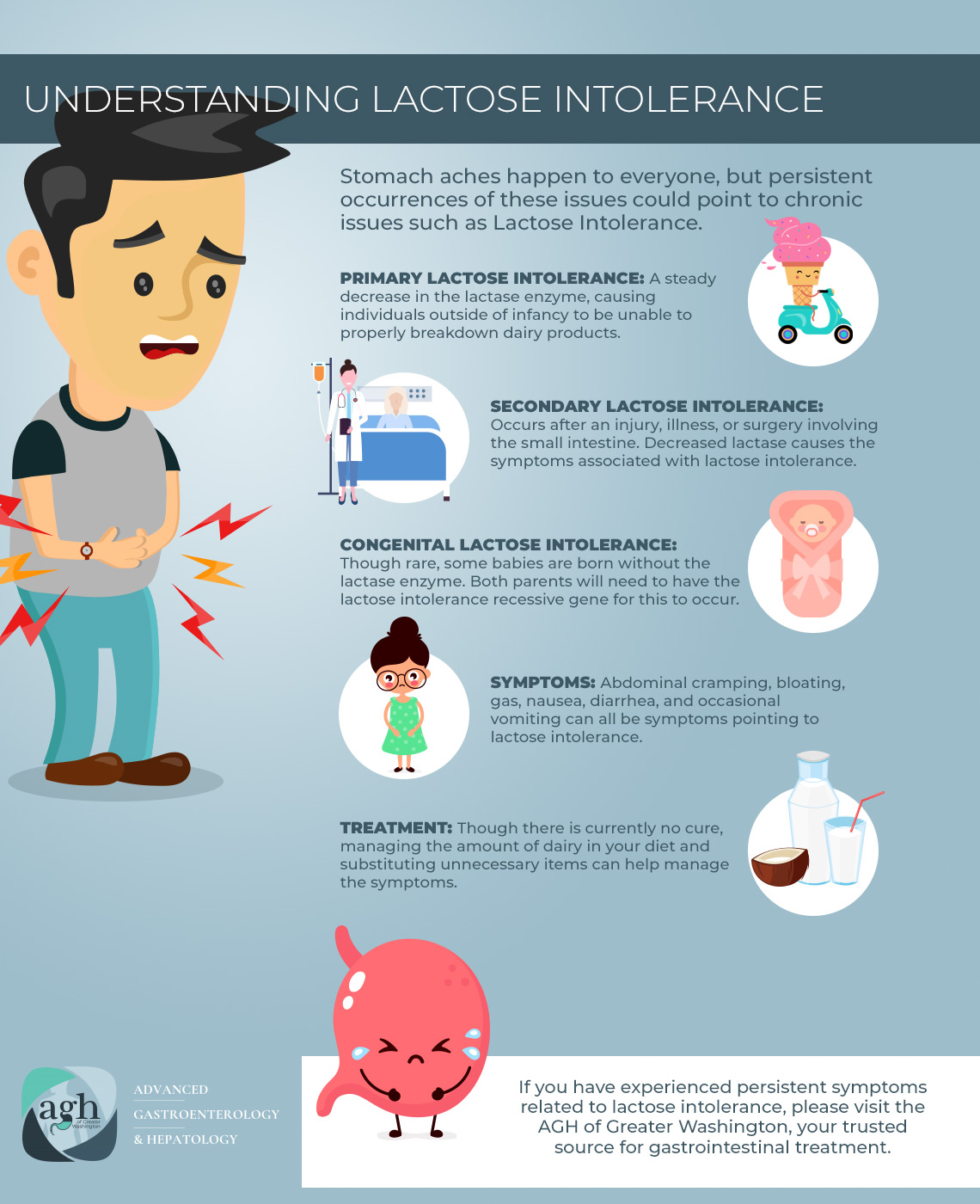 Infants with lactase deficiency do not tolerate human breast milk well.
Infants with lactase deficiency do not tolerate human breast milk well.
Types of lactase deficiency and milk allergy
Lactase deficiency occurs:
Primary lactase deficiency is a hereditary disease that results in a defect in the gene responsible for the production of this enzyme. For this reason, either its insufficient production or its complete absence occurs. As a rule, intolerance to milk and dairy products in such patients is a lifelong history.
Secondary lactase deficiency develops in patients with various inflammatory diseases of the small intestine. Intolerance to milk and dairy products in such patients is temporary. In most cases, after successful treatment of the underlying disease, the signs of milk intolerance disappear safely.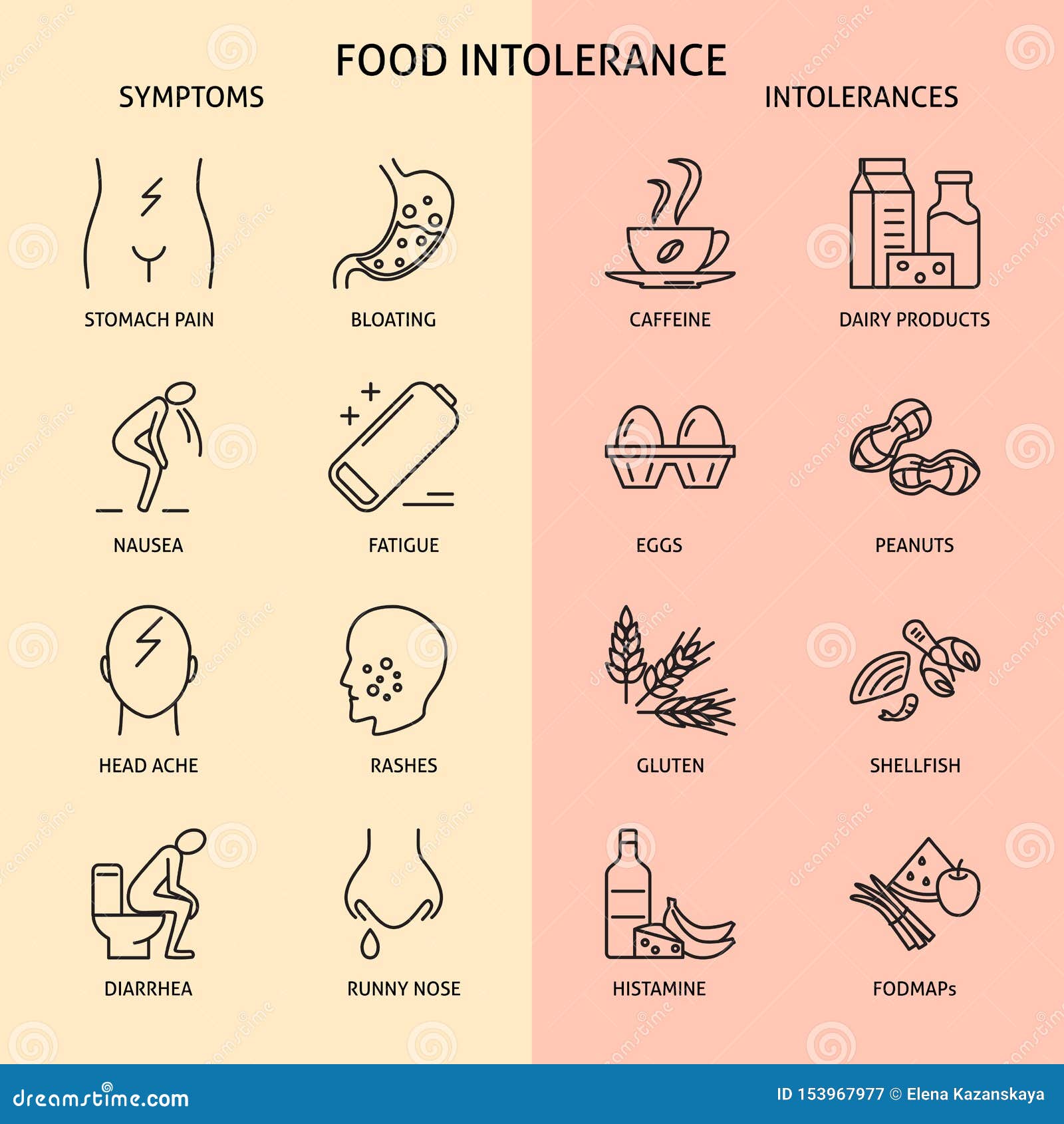
Cow’s milk protein allergy is a type of food allergy. It occurs in patients with pathologies such as:
- systemic allergies;
- atopic dermatitis;
- allergic bronchial asthma.
It can be said that it occurs in those patients who have an increased allergic background. An isolated food allergy to cow’s milk protein is possible. With this type of allergy, cow’s milk is usually poorly tolerated. But in addition to cow’s milk, goat’s and sheep’s milk are poorly tolerated. This happens because the antigenic compositions of goat and cow milk are similar to each other. And therefore, if there is an allergy to cow’s milk protein, then often there is an intolerance to goat’s, as well as sheep’s milk. But such patients tolerate breast milk quite well.
Signs of pathology
What do patients with lactase deficiency or allergy to cow’s milk protein usually complain about? These are mainly intestinal symptoms:
- pain in the abdomen of a cramping nature;
- nausea;
- swelling;
- rumbling in the abdomen;
- stool disorder (diarrhea or constipation).

And all this occurs after a short time after taking milk or dairy products. That is, their clinical picture is very similar. The only thing is that with an allergy to cow’s milk protein, it is possible to add an allergic rash or any other manifestations of allergic reactions of the body to the clinical picture.
In any case, such patients need to be consulted by a competent physician and examined for a correct diagnosis.
How to deal with lactose intolerance?
The basis for the treatment of patients with lactase deficiency and allergy to cow’s milk protein is an absolutely correct diet and the use of special dietary products. The qualitative composition and duration of the diet is established by the attending dietitian and depends on such individual parameters as:
- type of disease;
- patient age;
- degree of intolerance to milk and dairy products.
In recent years, medicine has stepped forward in the treatment of lactase deficiency. Previously, such patients were forced to limit or completely exclude from their diet such an important group as milk and dairy products, which are the main source of calcium, the deficiency of which develops osteoporosis. This is a disease that is characterized by bone fragility and a tendency to their increased fragility.
Previously, such patients were forced to limit or completely exclude from their diet such an important group as milk and dairy products, which are the main source of calcium, the deficiency of which develops osteoporosis. This is a disease that is characterized by bone fragility and a tendency to their increased fragility.
Currently, due to the fact that there are specialized dietary products, namely, lactose-free or low-lactose milk and dairy products are used, it has become possible to use enzymes containing lactase. This makes it possible not to limit patients in their daily full-fledged food intake, i.e., not to exclude such an important group of products as milk and dairy products.
Since the clinical picture of lactase deficiency and cow’s milk protein allergy are very similar, you should seek the advice of a specialist in order to make a correct diagnosis.
Sarkarova Medina Ramidinovna, general practitioner, gastroenterologist, nutritionist at the Healer clinic in Makhachkala, 8 years of experience.
Phone for inquiries and making an appointment with a specialist: 8-928-517-15-15.
Other items
Gadzhikuliev Nuri Babayevich
circumcision, urologist, surgeon, surgeon-urologist
Laser cutting in Makhachkala
Circumcision is the medical term for surgery to remove the foreskin, or as they say …
June 20, 2023
Shakhmilova Asiyat Mikailovna
neurologist
ADHD: what to do if you have a hyperactive child?
Children with increased physical activity are found in almost every modern family.
June 16, 2023
Sarkarova Medina Ramidinovna
gastroenterologist, nutritionist, therapist
All about diets: what is the best way to eat to lose weight?
There are about 15,000 different weight loss diets in the world. We will group the main diets and talk about them in more detail.
June 9, 2023
Inkova Aishat Inkavovna
neuro-ophthalmologist, ophthalmologist
Diseases of the optic nerve
The organ of vision is one of the most important analyzers. With its help, a person receives about 80% of information about the world around him, therefore …
With its help, a person receives about 80% of information about the world around him, therefore …
May 10, 2023
Lactase deficiency – articles from the specialists of the clinic “Mother and Child”
what is it
The main food of babies is milk (breast or formula). It contains many different nutrients (proteins, fats, carbohydrates), which, with the help of special digestive enzymes, are broken down into simple components and digested. But in young children, the gastrointestinal tract is still immature, there are few enzymes in it, others are not at all or they are not yet working at full capacity. When the baby grows up, there will be more enzymes, the digestive system will mature, but for now there may be various problems with it.
All milk (women’s, cow’s, goat’s, artificial mixtures) and dairy products contain the carbohydrate lactose, also called “milk sugar”. In order for lactose to be absorbed, the lactase enzyme must break it down, but if the child has little or no lactase enzyme, then lactose is not broken down and remains in the intestine. As a result, there is always a large amount of milk sugar in the intestines, which begins to ferment, and where there is fermentation, conditionally pathogenic flora actively reproduces. What we feel during fermentation: intestinal motility increases (it rumbles), plus gas formation increases (the stomach swells). But in an adult, this is usually a one-time situation due to some inaccuracies in nutrition, and it quickly passes. But in babies, everything is different, especially since they lack the enzyme not once, but constantly. What it looks like: The milk sugar lactose retains water, hence loose stools. In the child’s stomach, “rumbles and boils”, colic begins, the stool becomes frothy, greens, mucus and even blood may appear in it. If at first the stool was liquid, then constipation appears, and all this changes in a circle: yesterday there was diarrhea, today and tomorrow there is no stool at all, the day after tomorrow it is liquid again. And the most unpleasant thing is endless colic and endless crying, there is no rest for both the parents themselves and the baby.
As a result, there is always a large amount of milk sugar in the intestines, which begins to ferment, and where there is fermentation, conditionally pathogenic flora actively reproduces. What we feel during fermentation: intestinal motility increases (it rumbles), plus gas formation increases (the stomach swells). But in an adult, this is usually a one-time situation due to some inaccuracies in nutrition, and it quickly passes. But in babies, everything is different, especially since they lack the enzyme not once, but constantly. What it looks like: The milk sugar lactose retains water, hence loose stools. In the child’s stomach, “rumbles and boils”, colic begins, the stool becomes frothy, greens, mucus and even blood may appear in it. If at first the stool was liquid, then constipation appears, and all this changes in a circle: yesterday there was diarrhea, today and tomorrow there is no stool at all, the day after tomorrow it is liquid again. And the most unpleasant thing is endless colic and endless crying, there is no rest for both the parents themselves and the baby.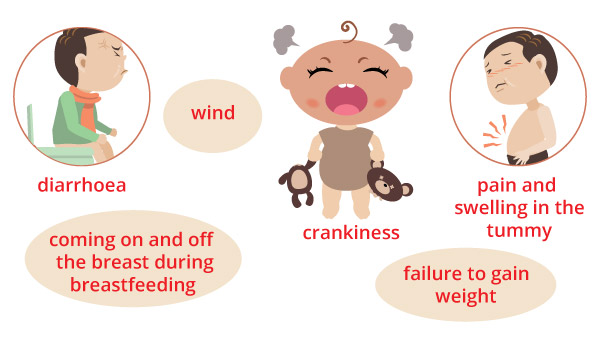 Mom at some point notices that the baby is crying just after feeding, and then a variety of advice falls upon her. “Your milk is bad, better give the mixture,” says the beloved mother-in-law. “Only breasts and nothing else!” – advise breastfeeding gurus. As a result, the mother tries one thing or the other, but neither breast milk nor artificial mixture gives relief to the child. Colic, crying and problems with the stomach and stool continue. The parents are in a panic because they don’t understand what is going on. In fact, this is a typical picture of bright lactase deficiency (LN), or insufficient production of the lactase enzyme.
Mom at some point notices that the baby is crying just after feeding, and then a variety of advice falls upon her. “Your milk is bad, better give the mixture,” says the beloved mother-in-law. “Only breasts and nothing else!” – advise breastfeeding gurus. As a result, the mother tries one thing or the other, but neither breast milk nor artificial mixture gives relief to the child. Colic, crying and problems with the stomach and stool continue. The parents are in a panic because they don’t understand what is going on. In fact, this is a typical picture of bright lactase deficiency (LN), or insufficient production of the lactase enzyme.
various reasons
There are several types of lactase deficiency, and it is with them that confusion arises.
Congenital lactase deficiency is a genetic and very rare disease (one case in several thousand newborns), it is difficult to confuse it with something, since it is very difficult. The diagnosis is made in the maternity hospital or in the first days after birth, the child does not have lactase at all, he quickly loses weight, he is immediately started to be fed intravenously or through a tube. Some experts (but not doctors) on breastfeeding read once that congenital lactase deficiency is an extremely rare disease, and that’s all – they further began to assure young mothers: “In fact, LN is extremely rare, you don’t have it, you don’t need to listen to doctors “, etc. Yes, congenital LN is a rare disease, but the key word here is “congenital”, and there are other types of lactase deficiency.
Some experts (but not doctors) on breastfeeding read once that congenital lactase deficiency is an extremely rare disease, and that’s all – they further began to assure young mothers: “In fact, LN is extremely rare, you don’t have it, you don’t need to listen to doctors “, etc. Yes, congenital LN is a rare disease, but the key word here is “congenital”, and there are other types of lactase deficiency.
Transient lactase deficiency in infants . And this is exactly the condition that occurs very often. The baby was born, and so far he still has little lactase enzyme, plus little normal intestinal microflora. Hence the colic, and loose stools, and mucus, and greenery, and crying, and the nerves of the parents. After a while, the child’s digestive system will fully mature, all enzymes will begin to work actively, the intestines will be populated with what is needed, and “lactase deficiency” will disappear. Therefore, such a LN is called “transient”, that is, temporary, or passing. It passes for someone a month after birth, for someone longer – after six to seven months, and there are children in whom lactase deficiency completely disappears only by the year.
It passes for someone a month after birth, for someone longer – after six to seven months, and there are children in whom lactase deficiency completely disappears only by the year.
Secondary lactase deficiency. This condition appears if a person has had some kind of intestinal infection, and it does not matter if it is an adult or a baby. For some time after the illness, the child does not tolerate milk (any), and then with proper nutrition and sometimes even without treatment, everything quickly passes.
Lactase deficiency in adults. There are people in whom the lactase enzyme begins to be lacking only in adulthood, this happens for various reasons: for some, lactase ceases to be produced in the right amount after some kind of illness, for other people, the activity of this enzyme simply fades over time by itself. yourself. As a result, at some age, a person begins to tolerate milk and dairy products poorly, although before that everything was fine. The symptoms are the same as in babies: he drank milk and after that the stomach rumbles, boils, and the stool is liquid. Sooner or later, a person realizes that milk is not his product, and simply stops drinking it in its pure form.
The symptoms are the same as in babies: he drank milk and after that the stomach rumbles, boils, and the stool is liquid. Sooner or later, a person realizes that milk is not his product, and simply stops drinking it in its pure form.
what to do
If there is transient lactase deficiency, then what to do with it? First you need to understand if it exists at all. Why does the child have problems with the stomach, stool, why does he cry all the time? Is it neurology, common colic, errors in the mother’s diet, an inappropriate mixture (if the baby is bottle-fed), improper breastfeeding technique, lactase deficiency, or a reaction to the weather? It can be difficult to figure it out right away, but if the tests show that there is lactase deficiency, then it is most likely in it. Now what to do next – treat it, wait for the enzymes to mature, or something else? Firstly, everything here will depend on how much the enzyme is lacking and, therefore, on how much LN worries the child and parents.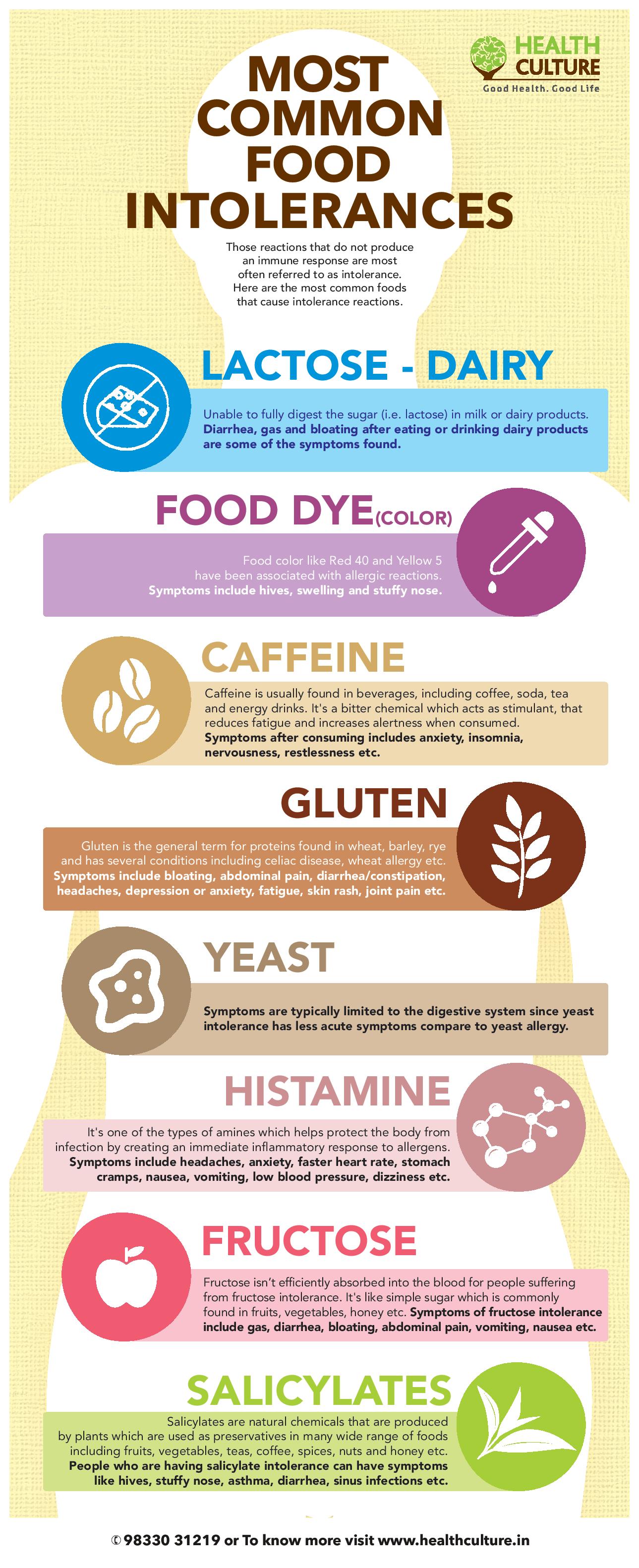 Some children lack the enzyme quite a bit, so their colic is mild and children cry quite normally. Plus, the violation of the stool is also not very bright: there are a couple of times a slightly liquefied stool, but that’s all. In other children, the lack of lactase is more pronounced, the child does not cry, but simply yells after each feeding, if at first he gained weight well, then after two months the increase is minimal, problems with stools begin in parallel (day – constipation, day – diarrhea), stool sometimes green, sometimes with mucus. Atopic dermatitis appears on the skin (the skin is the first to react to problems with the gastrointestinal tract). Parents have no rest day or night: the baby cries – he is fed – he cries again, they try to calm him down in other ways. But nothing helps. Mom and dad are in a panic, and no one has the strength anymore.
Some children lack the enzyme quite a bit, so their colic is mild and children cry quite normally. Plus, the violation of the stool is also not very bright: there are a couple of times a slightly liquefied stool, but that’s all. In other children, the lack of lactase is more pronounced, the child does not cry, but simply yells after each feeding, if at first he gained weight well, then after two months the increase is minimal, problems with stools begin in parallel (day – constipation, day – diarrhea), stool sometimes green, sometimes with mucus. Atopic dermatitis appears on the skin (the skin is the first to react to problems with the gastrointestinal tract). Parents have no rest day or night: the baby cries – he is fed – he cries again, they try to calm him down in other ways. But nothing helps. Mom and dad are in a panic, and no one has the strength anymore.
If parents see that the child may have signs of lactase deficiency, that he needs help, first of all, you need to look for a good doctor. Only an experienced pediatrician will be able to figure out why the baby has colic or green stools, what the numbers in the tests say, and what is the norm for one baby and the pathology for another. And of course, it is not necessary to cancel breastfeeding and immediately prescribe lactose-free or low-lactose artificial mixtures (even as a supplement). By itself, milk sugar lactose is very necessary for a child, when lactose is broken down, its components (glucose and galactose) go to the development of the brain, retina, for the life of normal intestinal microflora. So do not completely eliminate this sugar, you need to help it break down. With a strongly pronounced LN, the missing enzyme is given before each feeding (it has long been learned to produce and it is sold in pharmacies), with a dim clinic, its dose can be reduced. And it is also possible that there is lactase deficiency (even according to tests), but it does not need to be treated, there are almost no symptoms.
Only an experienced pediatrician will be able to figure out why the baby has colic or green stools, what the numbers in the tests say, and what is the norm for one baby and the pathology for another. And of course, it is not necessary to cancel breastfeeding and immediately prescribe lactose-free or low-lactose artificial mixtures (even as a supplement). By itself, milk sugar lactose is very necessary for a child, when lactose is broken down, its components (glucose and galactose) go to the development of the brain, retina, for the life of normal intestinal microflora. So do not completely eliminate this sugar, you need to help it break down. With a strongly pronounced LN, the missing enzyme is given before each feeding (it has long been learned to produce and it is sold in pharmacies), with a dim clinic, its dose can be reduced. And it is also possible that there is lactase deficiency (even according to tests), but it does not need to be treated, there are almost no symptoms.
But what cannot be done is to listen to non-specialists who deny either lactase deficiency itself or its treatment.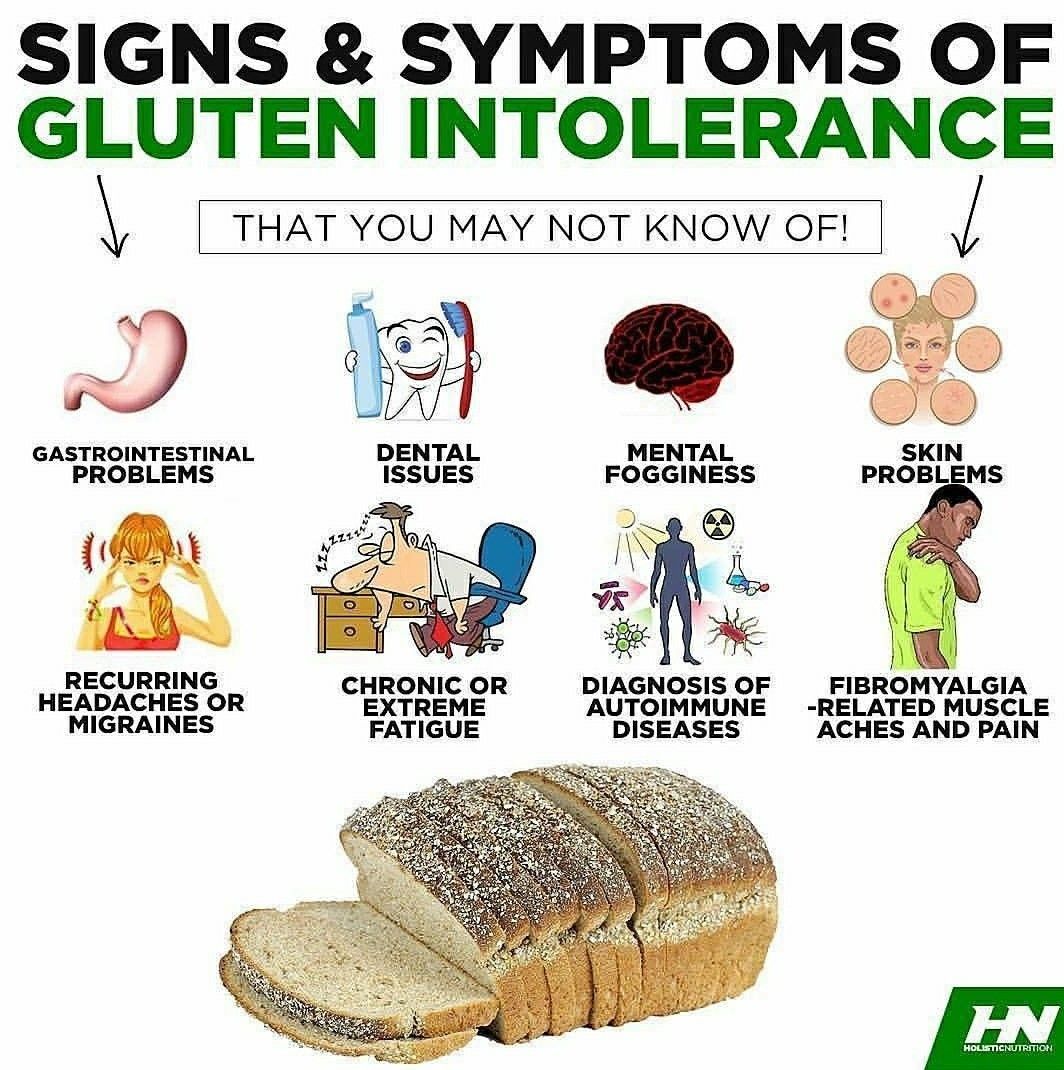 They see the cause of all problems with the child’s stomach and stool either in the wrong technique of breastfeeding, or partially admit that there is immaturity of the enzyme, but this is natural and will pass by itself. Yes, for some, LN is expressed easily and will pass quickly, but what about those parents whose child yells day and night, covered with a crust from atopic dermatitis and stopped gaining weight? Wait for the time to come and the enzymes to mature? Alas, with pronounced lactase deficiency (even if transient), enterocytes (intestinal cells) often suffer, so it is simply necessary to help such a child.
They see the cause of all problems with the child’s stomach and stool either in the wrong technique of breastfeeding, or partially admit that there is immaturity of the enzyme, but this is natural and will pass by itself. Yes, for some, LN is expressed easily and will pass quickly, but what about those parents whose child yells day and night, covered with a crust from atopic dermatitis and stopped gaining weight? Wait for the time to come and the enzymes to mature? Alas, with pronounced lactase deficiency (even if transient), enterocytes (intestinal cells) often suffer, so it is simply necessary to help such a child.
If you see that your baby has signs of lactase deficiency, look for a doctor who is committed to maintaining breastfeeding and has extensive experience. He will definitely help to find out why the baby is crying, why he has a stomach ache or has problems with stool. And then the life of the parents and the child will return to normal.
“Transient” (temporary) lactase deficiency in someone passes a month after birth, in someone longer – after six to seven months, and there are children in whom lactase deficiency completely disappears only by the year
If the tests show that there is a lactase deficiency, then the matter is most likely in it.



